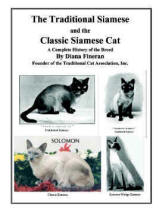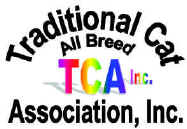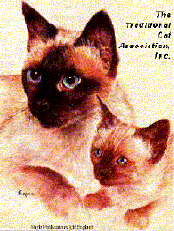|
Departments
eBook now Available!
|
Exclusive - THE book on Traditional & Classic
Siamese cats

Written by the Founder of TCA, Inc.
Tullycrine
Affordable
Web Design
|
|
|
THE TRADITIONAL TURKISH VAN©®
CAT FAQs (TV)
COPYRIGHT © Trademark ®
DIANA FINERAN
January 2, 2007
HISTORY - PERSONALITY - HEALTH
HISTORY
The Traditional Turkish Van has been around for hundreds
and even perhaps thousands of years and will be with us for a long time to come.
The history of this natural, magnificent breed is extensive and rich. Their
unique feature is a solid white cat with color restricted to the head and tail.
This coloration is attributed to the piebald gene, which is also known as
the ‘white spotting gene’ or the “piebald white spotting gene”.
There are several theories concerning the origin of the
Traditional Turkish Van. At some point it is mentioned, that long-haired breeds
(Including the Traditional Turkish Van, the Traditional Turkish Angora and the
Traditional Persian (Doll Face)) descended from the short hair African wildcat,
native to Asia and Africa.
The African wild cat posses the same chromosome number and structure as
domestic cats, and interbreeds easily with them. A different assertion tells us,
that they descended from a wild cat called the Pallas Cat or the Manul cat (Otocolobusmanul)
a long haired Asian wildcat, domesticated by the Tartars and Chinese, then later
by the Turks. The range of these original cats occupied the Caspian Sea, the
south shore of which is
Persia
(Now Iran).
Iran’s neighbor to the west is
Turkey, whose capital,
Ankara, was formerly called Van. Another source stated
that they came from the Lake Van area of south-eastern
Turkey, which resulted in these three breeds
being called “Van Cats” for a while.
The long hair gene is recessive and probably mutated spontaneously and was
perpetuated over centuries of inter-breeding in confined, mountainous regions
such as the Lake Van
region that limited out crossing.
The district of Van is snowed in for six months of the year, so these cats were
very hardy, and have extensive winter coats. However, it is very hot in Van in
the summer, so the cats shed to a much lesser coat in the summer months.
Legend has it that Mohammed (570 – 632), founder of the
Islamic faith, possessed a Traditional Turkish Van he regarded so highly that
rather than disturb it as it slept on his robe, he cut off the sleeve.
Mohammed’s Traditional Turkish Van was reputed to have been odd-eyed (one blue
eye and one gold eye).
The Traditional Turkish Van is believed to have originally
come from Van,
Turkey, the Persian
Province
of Chorazan, Iraq, Iran, Russia
and Afghanistan to Europe in the late 1500’s, with their principal color
being white. These cats have been domesticated for centuries, in fact for as
long as the famous Saluki Hound!
Their fur was of great value to the natives of Van, as it formed an important
article of commerce and was greatly sought after by merchants of surrounding
countries. The Traditional Turkish Van was said to be a great favorites of the
Armenians and Turks who especially enjoyed how their unique coat color
contrasted with their oriental furnishings and for their exceptional character.
A book about “Feline Husbandry” was written by Niels
Pedersen, who set forth what he called the “seven ancient mutations”.
One of these Mutations created long hair in cats. The others were solid
coloration, tabby striping, the dilution gene (which causes colors to produce a
lighter tone), sex-linked orange coloration, the white spotting factor and
dominant white. Of course, many
other mutations occurred over the centuries, but these seven occurred so long
ago, no one knows exactly when and where they developed.
All of these mutations are seen in the Traditional Turkish Van, as well
as in other breeds.
When such mutations occur in isolated areas, like the cold
plateaus of Turkey,
this trait is more likely to be spread through the existing cat population.
A speculation says the gene for long hair spontaneously arose in three
separate areas where cold harsh climates made the longer, insulating fur an
important part of survival. These
were Russia,
Persia (now Iran) and Turkey.
Because of the unforgiving environment and high elevations in
Turkey, cats with long fur had dominance.
Another belief is that the mutation developed in only one of these places
and was then transported to the others later. At some point they manifested the
dominant white gene.
With so many village, towns and even a
Lake Van sharing the common name, it stand to reason that the unique
long haired cat from that region would become known as the Turkish Van.
The first long haired cats seen in Europe in the sixteenth
century came from Van or Ankara in Turkey.
They were referred to as Vans, later called Persians and later referred
to as long-haired.
During the 1600’s these famous cats made their way to
Europe by caravans on the important Turkish, Russian and Persian trade routes
between Europe and the Middle East. Rare animals were a marketable transport. By
1626 they had arrived in
Italy.
The French naturalist, Count de Buffon, observed in the
mid-18th century that cats in Persia “except in color bore a
perfect resemblance to the cat of the Van.”
In 1947 the Van was described as being imposing, white in
color with a magnificent plumed tail. Even though they came in several other
colors, breeders at that time were endeavoring to keep them only pure white with
great success because white propagates itself with consistency.
The Van was considered a parlor cat, very sensitive to cold and dampness
and consequently delicate in constitution.
Their owners were warned not to feed them tripe, giblets, or scraps of
fish, since their digestion would upset much sooner than that of other cats.
Vans and Persians were highly valued when they were purebreds.
Yet, many young Vans were sold without their new owners knowing what they
had purchased. For a while all long-haired cats were called “Vans”, and then for
a while they were called “Persians”.
The ordinary person made no distinction between breeds. The Traditional Turkish
Angora, the Traditional Turkish Van, and Russian Long-hairs were
indiscriminately used extensively in Traditional Persian breeding programs to
add length and silkiness to the Persian coat.
Slowly the term “Van” in relationship to long-haired cats
in
England
was seldom if ever used in that country.
A typical Van rarely existed then, so it was offensive to breeders to see
a number of badly bred, long-haired cats advertised and spoken of as Vans.
The general public in England at the time thought of any
long-haired cat as an Van. Even poor
Maine Coons were termed Vans.
Whatever the Van was originally, it had become far removed from purebred Vans.
The purebred, imported long-haired cats were thought to be a cross of the Van
and the Persian. The Persian
possessed a rounder head than the Van. Also their coats were quite different.
The coat of a Persian then had a wooly under coat and a long, hairy outer
coat. Their hair was somewhat shorter on the shoulders and upper part of the
hind legs. The Van, on the other had, had a long, soft hair, hanging in locks,
inclining to a slight curl or wave on the under parts of the body. Their hair
was much longer on the shoulders and hind legs than the Persians, and was not so
plentiful nor evenly profuse as the Persian’s.
The Van had a more wedge-shaped head, compared to the Persians roundness
of face. Of course the Vans and Persians of the 1940’s era were constantly
crossed with each other, causing what was considered a decided improvement to
each breed. Even Traditional Russian Blues were used.
The long-haired cat of the 1940’s was decidedly more Persian bred than
Van. The Persian breeders liked the resulting long, locky coat, especially where
great length of coat was produced on the shoulders and legs.
As we see the three breeds were interbred, and when that
was done, the Traditional Turkish Angora and the Traditional Turkish Van
characteristics tended to disappear and the Traditional Persian (Doll Face)
dominated. In time, true Traditional
Turkish Angoras and Traditional Turkish Vans ceased to exist as pure breeds and
vanished from the western world. By the 1900’s they had virtually vanished from
America
too. By 1909 Dorothy Champion, an American Persian breeder, declared, “That the
term “Van” should be seldom if ever used in this country as a typical Van
scarcely exists. The long haired cat
of today is decidedly more Persian-bred than Van.” However, only in the mid
1950’s was the term “Persian” adopted as a breed name.
All longhairs simply continued to be registered as longhairs, even though
the cat world had been calling them Persians for more than half a century.
They were brought to England in 1955 by British
Photographers, Laura Lushington and Sonia Halliday.
In 1969 “Turkish Cats’ were accepted by
the GCCF in England. The Breed Standard at that
time called for a mostly white cat with auburn spots on the forehead and an
auburn tail, ringed in light and dark shades. It was supposed to have Amber
eyes.
They arrived in the Unites States in the early 1970’s with
servicemen who were stationed in Turkey at that time. In 1983 Barbara
and Jack Reark of Miami, Florida imported a pair from
France
and the more from the
Netherlands.
The Reark’s were the first to promote the breeding of Traditional Turkish
Vans in the U.S.
PERSONALITY
The Traditional Turkish Van is second to none. Strong,
adaptable, lively, mischievous, friendly, docile, poised, regal, graceful,
beautiful, and elegant, they are truly the aristocrats of the long-hairs.
Usually they are gentle and easy to get along with, who make colorful,
affectionate, playful pets. The whole house is their cat toy with any small
object becoming a hockey puck. Climbing on furniture, door tops and shelves,
while looking down at their owner is normal fun to them. They bond with their
owners completely and are not happy unless they are right in the middle of
things. A good conversation is
always enjoyed, as they can keep up their end of the dissertation.
A determined nature makes it difficult to change their mind once they get
an idea into their head. Extremely intelligent, they are quick to learn simple
tricks, such as fetching or laying catch with a soft ball. Helping to make beds,
cook, and do laundry is on their “to do” list. If nothing is going on, they will
make something happen. They can solve a problem and are eager to “show off” to
company. They will tolerate being held for only a short time before wanting down
to bat at sunbeams and chase toys. Some don’t like to be held at all.
Even kittens are capable of jumping to
your eye level from a standing start, when chasing a toy. Described as “pure
poetry in motion”, “animated, fluid grace”, “Living sculptures in fur”, and
“there’s nothing better on four paws”, owners are always emphatic about the
wonderful temperament and personality of this breed. Their symmetry and devotion
evoke strong responses of loyalty from their human family.
Unlike other
long-haired breeds, the Traditional Turkish Van does not need a lot of grooming,
because they have no wooly, downy undercoat. Their fur doesn’t mat the way a
Persians is prone to do. They keep
themselves very clean. A once a week combing does them well. Some of their
owners claim that their usual allergies or asthma don’t flare up around
Traditional Turkish Vans, perhaps because of their single coat.
In additional to their great capacity for affection and
alert intelligence, their outstanding characteristic is their liking for water,
not usually regarded as a feline attribute. Not every Traditional Turkish Van
enjoys water, but many do. Those who
do not only dabble in water and play with it, but have been known to voluntarily
enter ponds and even warm horse-troughs for a swim. Even when young kittens they
swim in shallow streams and still water. They soon became famous as the
‘swimming cats”.
Since their coat has no under coat they dry out faster.
Actually their coat is quite water repellant. Dirt doesn not easily cling
to the coat.
As parents, they have healthy, robust kittens with little
difficulty and with much enjoyment from courtship to the raising of their
kittens.
HEALTH
The breed is a healthy one, with no known genetic defects.
Deafness is not association with the Traditional Turkish
Van.
Top
|
|
|

 The
Traditional Cat Association,
Inc.©1987®TM
Official Website
The
Traditional Cat Association,
Inc.©1987®TM
Official Website